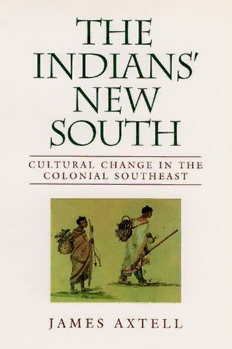
The Indians’ New South: Cultural Change in the Colonial Southeast PDF
Preview The Indians’ New South: Cultural Change in the Colonial Southeast
THE WALTER LYNWOOD FLEMING LECTURES IN SOUTHERN HISTORY THE INDIANS' NEW SOUTH THE INDIANS' NEW SOUTH CULTURAL CHANGE IN THE COLONIAL SOUTHEAST JAMES AXTELL LOUISIANA STATE UNIVERSITY PRESS BATON ROUGE Copyright © 1997 by James Axtell All rights reserved Manufactured in the United States of America 06 05 04 03 02 5 43 Designer: Rebecca Lloyd Lemna Typeface: 10.5 on 13 Galliard Typesetter: Impressions Book and Journal Services, Inc. Library of Congress Cataloging-in-Publication Data Axtell, James. The Indians' new south : cultural change in the colonial southeast / James Axtell. p. cm. — (The Walter Lynwood Fleming lectures in southern history) Includes index. ISBN 0-8071-2171-1 (alk. paper). -ISBN 0-8071-2172-X (pbk. : alk. paper) 1. Indians of North America—Southern States—History. 2. Indians of North America—Southern States—Social conditions. 3. Indians of North America—Southern States—Government relations. 4. Spain- Colonies—America. 5. America—Discovery and exploration—Spanish. I. Tide. II. Series. E78.S65A97 1997 975'.02-dc21 96-39945 CIP The paper in this book meets the guidelines for permanence and durability of the Committee on Production Guidelines for Book Longevity of the Council on Library Resources. @ FOR SUSAN CONTENTS Acknowledgments xiii INTRODUCTION : THE FIRST SOUTHERNERS I I THE SPANISH INCURSION 5 II THE WIDENING STAIN 25 III MAKING DO 45 Notes 73 Index 97 ILLUSTRATIONS MAP Selected Southeastern Tribes at First Contact with Europeans xvi FOLLOWING PAGE 54 A Creek man and woman, by William Bonar (1757) An Indian Camp as They Make Them When They Are Hunting, by Philip Georg Friedrich von Reck (1736) Indians Going A-hunting, by Philip Georg Friedrich von Reck (1736) A War Dance, by Philip Georg Friedrich von Reck (1736) The Indian King and Queen of the Yuchis, by Philip Georg Friedrich von Reck (1736) The Supreme Commander of the Yuchi Indian Nation, by Philip Georg Friedrich von Reck (1736) ACKNOWLEDGMENTS WHEN I was asked to deliver the fifty-eighth series of Walter Lynwood Fleming Lectures in Southern History, I was at once delighted and nonplussed. No historian could be anything but honored by an invitation to talk in the series that is not only the touchstone and standard in the history of the South but one of the oldest and most venerated in the profession. But I was also some- what worried because I was asked to follow a very long line of dis- tinguished predecessors who had made their names in southern history and because so few of them were colonial historians, per- haps three or four, depending on how or whom you count. Not only did the vast majority of them focus on the nineteenth-century South, with the Civil War at its heart, but none of them had treated the Indians as lead, or even supporting, actors in southern history. My anxiety only grew because I have never considered myself exclusively or even mainly a "southern historian." Despite our eigh- teen years in Virginia, I've always thought of my professional self as a historian of "colonial North America," with a primary focus east of the Mississippi, not south of the Mason-Dixon Line. But then I remembered two saving facts (if rationalization leads to salvation). First, despite the absence of titles with South or southern in them on my e.V., my research, especially in the past fifteen years, and my teaching always have paid lots of attention to the Southeast and its polychromatic inhabitants. And second, though I was raised in upstate New York and taught to celebrate (if that is the right word for a passei offallen monks, horse thieves, and regicides) my English and New English ancestors, I had stumbled on a parallel southern ancestry several years ago while looking for something else in colo- nial South Carolina. If Landgrave Lady Axtell is not enough to earn xiii ACKNOWLEDGMENTS me at least honorary status as a "southern" historian, I have nothing else to offer, except contemporary residence in the Old Dominion. Fortunately, none of these tergiversations seems to have both- ered the history department at Louisiana State University, who chose me for this signal honor. I am extremely grateful to them and to chairpersons Paul Paskoff and Anne Loveland for enabling me to earn my bona fides, however small, as a southern historian and for their gracious hospitality and good company during my visit in April 1996.1 was much taken with the southern charms of the LSU campus, including its Indian mounds and live tiger mascot, and of Red Stick, about which I have read so often in the journals of Iberville, Pénicaut, and Father Du Ru. I owe Paul Hoffman a par- ticular debt for serving as genial tour guide of Natchez (the town and mounded Indian site) and of Cajún cuisine avec musique. He, and fellow long-time friends David Weber, Bill Taylor, and Tim Breen, kindly but firmly applied their red pencils to the manuscript when it needed them most. Thanks, too, to the affable and efficient staff of the Earl G. Swem Library at William and Mary, particularly the folks in Interlibrary Loans who good-naturedly honor my requests for odd prints hither and yon. Maureen Hewitt and John Easterly, my editors at LSU Press, not only attended the lectures faithfully but added enthusiasm to editorial skill in producing this little book. I appreciate their high standards almost as much as their tolerance of an author keen to meddle in book design. Finally, to my wife Susan, my amusing and bemused muse, goes my profoundest thanks of all. Day in and out, with high tol- erance, quiet faith, and consummate grace, she allows me to chase my bookish fancies and fantasies. She is my ideal reader, in every sense. My dedication is small return for hers. xiv
